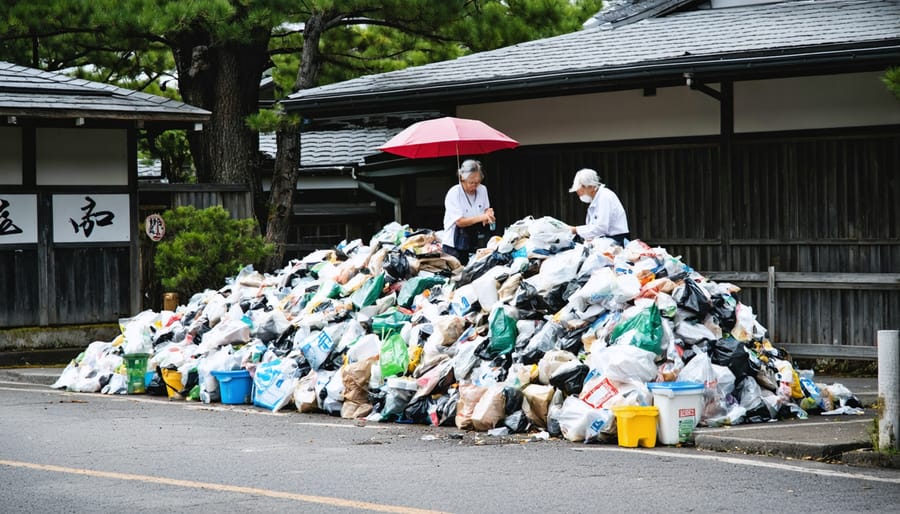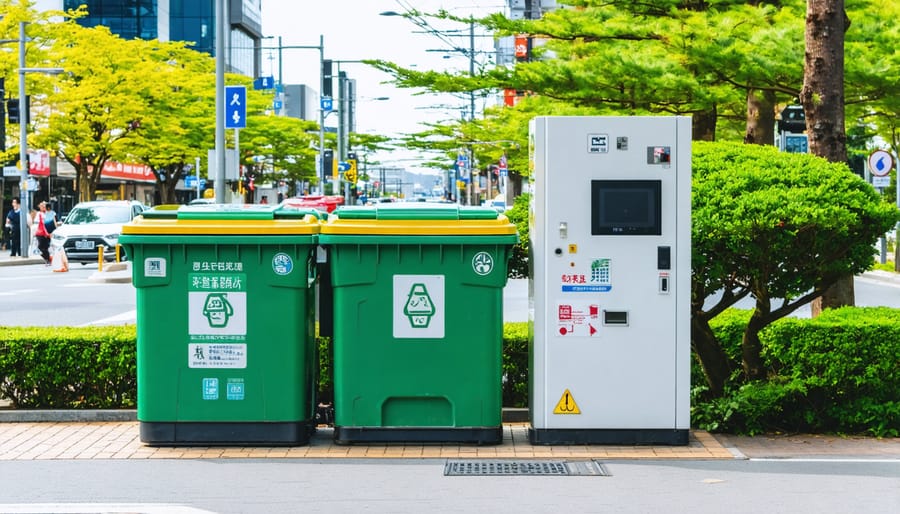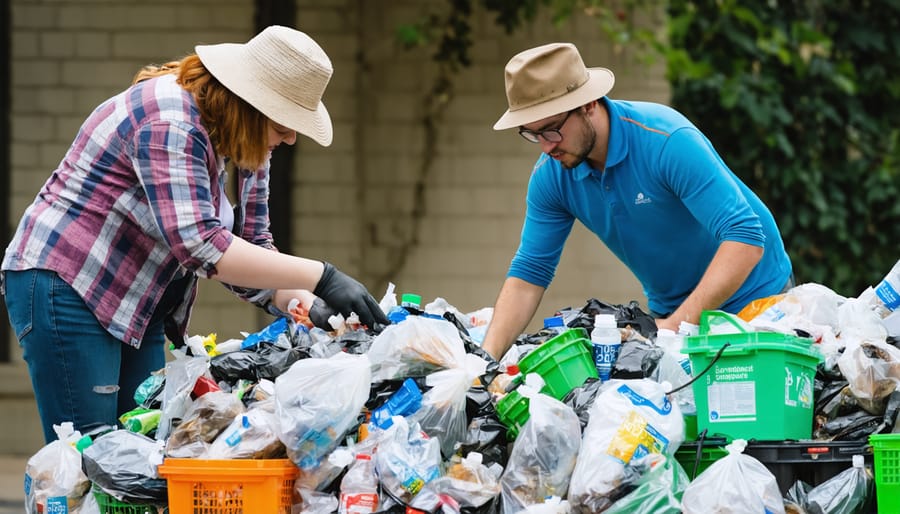In a nation where space comes at a premium, Japan’s revolutionary waste management system stands as a global benchmark for efficiency and sustainability. From the bustling streets of Tokyo to quiet suburban neighbourhoods, the country has transformed its approach to waste from a municipal burden into a model of civic responsibility and environmental stewardship.
What truly sets Japan apart isn’t just its impressive 84% recycling rate, but how seamlessly waste management has been woven into the fabric of daily life. Through a combination of innovative technology, community engagement, and cultural values that emphasise respect for shared spaces, Japan has created a waste management system that Australian communities can learn from and adapt.
In metropolitan Japan, the average resident produces just half the waste of their Australian counterpart, yet maintains one of the world’s highest standards of living. This remarkable achievement stems from a holistic approach that balances strict regulations with practical solutions, proving that effective waste management isn’t just about infrastructure – it’s about creating a culture of consciousness and responsibility.
As Australian cities grapple with growing waste challenges, Japan’s journey offers valuable insights into how communities can transform their relationship with waste while building a more sustainable future.
The Japanese Waste Management Model: A Blueprint for Success
The 3R Initiative: Reduce, Reuse, Recycle
At the heart of Japan’s waste management success lies the 3R Initiative, which has transformed how Japanese citizens approach their waste reduction habits. This comprehensive strategy prioritises reducing consumption, reusing items whenever possible, and recycling materials that can’t be repurposed.
The ‘reduce’ component encourages mindful purchasing and minimal packaging, with many Japanese retailers offering package-free options and refill stations. This approach has helped slash household waste by up to 30% in participating communities.
‘Reuse’ is deeply embedded in Japanese culture, with repair shops and second-hand stores being common fixtures in neighbourhoods. Items like bottles, containers, and electronics are often designed for multiple uses, extending their lifecycle and reducing waste.
The ‘recycle’ aspect involves sophisticated sorting systems, with some communities separating waste into up to 45 categories. This meticulous approach ensures maximum resource recovery and minimal landfill impact. Japanese citizens typically wash and sort their recyclables at home, demonstrating how individual action contributes to collective success.
This initiative has not only reduced waste but has created a culture of responsibility that Australian communities can learn from and adapt to local contexts.
Technology Meets Tradition
In Japan’s pursuit of efficient waste management, cutting-edge technology seamlessly integrates with deeply rooted cultural values. Smart bins equipped with AI sensors sort waste automatically, while mobile apps help residents track collection schedules and proper disposal methods. These innovations complement traditional Japanese reuse and recycling practices that have been passed down through generations.
The marriage of old and new is particularly evident in waste processing facilities, where robots work alongside human sorters, combining mechanical precision with traditional knowledge of material recovery. Local communities use digital platforms to organize neighbourhood clean-ups and share resources, building on the long-standing Japanese principle of ‘mottainai’ – the concept that waste is shameful and resources should be used respectfully.
This blend of innovation and cultural wisdom has created a system that’s both efficient and culturally meaningful. It’s an approach that Australian communities can learn from, showing how modern solutions can enhance rather than replace traditional values in waste management.
Innovative Sorting and Collection Systems
Community-Based Waste Management
In Japan, community participation forms the backbone of successful waste management, offering valuable lessons for Australian communities. Neighbourhoods actively engage in sorting waste through well-established systems that have become part of daily life. Local community groups, known as “chonaikai,” play a crucial role in educating residents about proper waste disposal and organizing collection schedules.
What’s particularly inspiring is how Japanese communities have turned waste management into a social activity. Regular cleanup events, called “clean-up days,” bring neighbours together to maintain their shared spaces while strengthening community bonds. These events often include educational components where experienced community members mentor newcomers about proper sorting techniques and waste reduction strategies.
Many Japanese municipalities have implemented “waste stations” managed by local volunteers. These designated collection points serve as both practical facilities and community hubs where residents can seek advice about recycling and waste reduction. The system relies on mutual accountability, with community members taking responsibility for maintaining these stations and ensuring compliance with sorting rules.
For Australian communities looking to adopt similar practices, the Japanese model demonstrates how local engagement can transform waste management from a municipal service into a community-driven initiative. Several Australian councils have already begun experimenting with community-led waste programs, drawing inspiration from Japan’s successful approach to creating sustainable, waste-conscious neighbourhoods.

Smart Collection Points
Japan’s innovative approach to waste collection showcases how technology and community participation can work hand in hand. Their smart collection points, strategically placed throughout neighbourhoods, feature automated systems that efficiently sort and compact waste while providing real-time data on collection needs.
These high-tech collection points often include sensors that monitor fill levels, automatically alerting collection services when bins are near capacity. This prevents overflow and optimises collection routes, reducing fuel consumption and carbon emissions. Some collection points even feature solar-powered compactors that can hold up to five times more waste than traditional bins.
What’s particularly impressive is how these systems integrate with mobile apps, allowing residents to check the nearest available collection points and their current capacity. In dense urban areas, underground collection points are becoming increasingly common, using pneumatic systems to transport waste directly to processing facilities through underground pipes.
For Australian communities looking to modernise their waste management, Japan’s smart collection points offer valuable lessons. Several councils in metropolitan areas are already piloting similar systems, adapting the technology to suit local needs. The initial investment in smart collection infrastructure is offset by reduced operational costs and improved efficiency over time.
These systems have shown particular success in high-density areas and commercial districts, where traditional collection methods often struggle with space constraints and timing issues. The technology also helps track recycling rates and contamination levels, providing valuable data for improving community education programs.

Lessons for Australian Cities
Adapting Japanese Solutions
While Japan’s waste management systems are impressive, implementing them in Australia requires thoughtful adaptation to our unique cultural and infrastructural context. The key is to start with manageable changes that align with existing environmentally conscious disposal methods while gradually introducing more sophisticated practices.
Local councils can begin by introducing simplified sorting systems, starting with three or four waste streams instead of Japan’s more complex categories. This makes the transition easier for residents while still improving recycling rates. Educational programs can focus on Australian-specific challenges and solutions, using familiar examples and local success stories to inspire change.
Community-based initiatives can adapt Japan’s neighbourhood group system to suit Australian suburbs. Regular street or neighbourhood meetings could focus on waste reduction strategies, while community composting programs can bring neighbours together while addressing organic waste management.
For apartment buildings, modified versions of Japan’s space-saving waste storage solutions can be implemented, considering our different architectural styles and council collection methods. Simple innovations like compact sorting bins and designated collection points can make waste management more efficient in high-density areas.
Businesses can adopt Japanese-style waste tracking systems, modified to work with Australian regulations and reporting requirements. This could include simplified waste audits and clear labelling systems that help staff and customers properly sort their waste.
The key to successful adaptation is maintaining flexibility while preserving the core principles of Japanese waste management: responsibility, efficiency, and community involvement. By starting small and scaling up gradually, Australian communities can build sustainable waste management systems that work for our unique context.
Building Community Engagement
In Japan, community engagement isn’t just a buzzword – it’s the cornerstone of their successful waste management system. From neighbourhood clean-up days to local recycling champions, Japanese communities have mastered the art of collective responsibility for waste management.
At the heart of this engagement are the community waste stations, where neighbours meet regularly to sort their recyclables. These stations become social hubs where residents share tips and encourage each other to maintain proper waste separation. This model could work brilliantly in Australian neighbourhoods, particularly in areas with strong community ties like local sports clubs or community gardens.
Schools play a vital role too, with Japanese children learning waste management practices from an early age. They participate in hands-on activities like composting projects and recycling drives, taking these habits home to influence their families. Many Australian schools are already adopting similar programs, showing promising results in raising environmental awareness.
Local governments in Japan support these initiatives through regular workshops and educational campaigns. They make waste management engaging through mascots, interactive apps, and community events. These strategies resonate particularly well with young families and tech-savvy residents – demographics that are increasingly environmentally conscious in Australia.
The key to Japan’s success lies in making waste management a shared responsibility rather than an individual burden. By fostering a sense of community pride in maintaining clean, waste-conscious neighbourhoods, they’ve created a sustainable model that Australian communities can adapt and embrace.

Implementation Challenges and Solutions
Infrastructure Requirements
Japan’s sophisticated waste management system relies on a carefully planned infrastructure network that has evolved over decades. At its core are strategically located processing facilities, designed to handle different waste streams efficiently while minimising environmental impact. These facilities include state-of-the-art incineration plants equipped with advanced emission control systems, material recovery facilities, and composting centres.
What’s particularly noteworthy for Australian communities is Japan’s emphasis on local processing. Most municipalities operate their own waste treatment facilities within city limits, reducing transportation costs and emissions. These facilities are designed to blend seamlessly into urban landscapes, often featuring innovative architectural elements and educational centres that engage the community.
The infrastructure extends beyond processing facilities to include an extensive network of collection points and sophisticated sorting stations. Many Australian councils could adopt Japan’s approach of establishing clean, well-maintained neighbourhood collection points that encourage proper waste separation.
Storage infrastructure is another crucial element, with facilities designed to temporarily hold recyclable materials until market conditions are optimal for processing. This approach helps maintain the economic viability of recycling programs, something particularly relevant for Australian communities dealing with fluctuating recycling markets.
Technology plays a vital role, with automated sorting systems, RFID tracking for waste bins, and real-time monitoring of waste flows. While the initial investment in such infrastructure is significant, the long-term benefits in reduced landfill costs and increased resource recovery make it a worthwhile consideration for Australian municipalities looking to upgrade their waste management systems.
Cultural Adaptation Strategies
Adopting Japanese waste management practices in Australia requires careful consideration of cultural differences and local community dynamics. Success lies in adapting these practices to fit our unique Australian lifestyle while maintaining their core principles.
One effective strategy is the introduction of “Waste Warriors” programs in local communities, where volunteers champion proper waste sorting and recycling practices. These community leaders share their knowledge through informal neighbourhood gatherings, making the transition to new waste habits feel more natural and achievable.
Schools play a crucial role in cultural adaptation. Many Australian schools have already implemented “Bento-style” lunch programs, encouraging students to pack waste-free lunches using reusable containers. This approach not only reduces waste but also helps children develop sustainable habits early in life.
Local councils are finding success with “Step-by-Step” implementation programs, introducing new waste sorting categories gradually rather than all at once. This measured approach allows communities to adapt at a comfortable pace, reducing resistance to change.
Community festivals and events are being reimagined as “Zero Waste Zones,” incorporating Japanese-inspired waste stations with clear signage and volunteer guides. These events serve as practical learning opportunities where residents can experience proper waste sorting in a supportive environment.
Small business engagement has proven particularly effective, with cafes and restaurants leading the way in adopting waste reduction practices. Many now offer discounts for customers bringing reusable containers, creating a positive reinforcement system that encourages sustainable behaviours.
Japan’s waste management success story offers valuable lessons for Australian communities looking to create a more sustainable future. Through their commitment to the 3Rs – reduce, reuse, and recycle – and innovative technological solutions, Japan has demonstrated that effective waste management is achievable with dedication and community participation.
As we face our own waste management challenges in Australia, we can draw inspiration from Japan’s systematic approach while adapting it to our unique context. The implementation of similar sorting systems, public education programs, and community engagement initiatives could significantly improve our waste management outcomes.
The key to success lies in our collective effort. Local councils can take the lead by introducing better sorting systems and education programs, while businesses can adopt more sustainable packaging practices. As individuals, we can start by implementing simple sorting habits at home and supporting local recycling initiatives.
Let’s embrace this opportunity to transform our waste management practices. By working together and learning from Japan’s example, we can create cleaner, more sustainable communities across Australia. The time to act is now – every small step towards better waste management contributes to a more sustainable future for generations to come.
